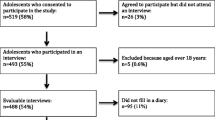Abstract
The aim of the study presented is to examine the psychometric properties of two parent–report scales for the assessment of environmental factors in pediatric headache, namely, the Children's Headache Assessment Scale (CHAS) and the Illness Behavior Encouragement Scale (IBES). Data were gathered in a sample of 160 parents of children suffering from headaches regularly. The internal structure of both scales is investigated by means of confirmatory factor analysis. The internal consistency of the resulting subscales is explored and data on the convergent validity and on the relationship with demographics are presented. Both the CHAS and the IBES appear to be promising assessment tools in a behavioral approach to pediatric headache.
Similar content being viewed by others
REFERENCES
Altshuler, J. L., and Ruble, D. N. (1989). Developmental changes in children's awareness of strategies for coping with uncontrollable stress. Child Dev. 60: 1337-1349.
Andrasik, F., Blake, D. D., and McCarran, M. S. (1986). A biobehavioral analysis of pediatric headache. In Krasnegor, N. A., Arasteh, J. D., and Cataldo, M. F. (eds.), Child Health Behavior: A Behavioral Pediatrics Perspective, Wiley, New York, pp. 394-434.
Barker, C., Pistrang, N., and Elliott, R. (1994). Research Methods in Clinical and Counseling Psychology, John Wiley & Sons, Chichester.
Bentler, P. M. (1990a). Comparative fit indices in structural models. Psychol. Bull. 107: 238-246.
Bentler, P. M. (1990b). Fit indices, Lagrange multipliers, constraint changes and incomplete data in structural models. Multivar. Behav. Res. 25: 163-172.
Bollen, K. A., and Long, J. S. (1993). Introduction. In Bollen, K. A., and Long, J. S. (eds.), Testing Structural Equation Models, Sage, Newbury Park, CA, pp. 1-9.
Brown, J. M., O'Keefe, J., Sanders, S. H., and Baker, B. (1986). Developmental changes in children's cognitions to stressful and painful situations. J. Pediatr. Psychol. 11(3): 343-357.
Browne, M. W., and Cudeck, R. (1993). Alternative ways of assessing model fit. In Bollen, K., and Lang, S. (eds.), Testing Structural Equation Models, Sage, Newbury Park, CA, pp. 136-162.
Budd, K. S., and Kedesdy, J. H. (1989). Investigation of environment al factors in pediatric headache. Headache 29: 569-573.
Budd, K. S., Workman, D. E., Lemsky, C. M., and Quick, D. M. (1994). The Children's Headache Assessment Scale (CHAS): Factor structure and psychometric properties. J. Behav. Med. 17(2): 159-179.
Cole, D. A. (1987). Utility of confirmatory factor analysis in test validation research. J. Consult. Clin. Psychol. 55(4): 584-594.
Curry, S. L., and Russ, S. W. (1985). Identifying coping strategies in children. J. Clin. Child Psychol. 14(1): 61-69.
Durand, V. M., and Crimmins, D. B. (1988). Identifying the variables maintaining self-injurious behavior. J. Autism Dev. Disord. 18: 99-117.
Hermann, C., Kim, M., and Blanchard, E. B. (1995). Behavioral and prophylactic pharmacological intervention studies of pediatric migraine: An exploratory meta-analysis. Pain 60(3): 239-255.
Hoelscher, T. J., and Lichstein, K. L. (1984). Behavioral assessment and treatment of child migraine: Implications for clinical research and practice. Headache 24: 93-103.
Jöoreskog, K. G., and Sörbom, D. (1983). LISREL V: Analysis of Linear Structural Relationships by the Method of Maximum Likelihood, International Educational Sciences, Chicago.
Jöoreskog, K. G., and Sörbom, D. (1984). LISREL VI User's Guide, 3rd ed., Scientific Software, Mooresville, IN.
Kazak, A. E., Penati, B., Waibel, M. K., and Blackall, G. F. (1996). The Perception of Procedures Questionnaire: Psychometric properties of a brief parent report measure of procedural distress. J. Pediatr. Psychol. 21: 195-207.
La Greca, A. M., and Lemanek, K. L. (1996). Editorial: Assessment as a process in pediatric psychology. J. Pediatr. Psychol. 21: 137-151.
Lake, A. E. (1981). Behavioral assessment considerations in the management of headache. Headache 21: 170-178.
Lansky, S. B., List, M. A., Lansky, L. L., Ritter-Sterr, C., and Miller, D. R. (1987). The measurement of performance in childhood cancer patients. Cancer 60: 1651-1656.
Marsh, H. W., Balla, J. R., and McDonald, R. P. (1988). Goodness-of-fit indices in confirmatory factor analysis: The effect of sample size. Psychol. Bull. 103: 391-410.
Metsähonkala, L., Sillanpaä, M., and Tuominen, J. (1997). Headache diary in the diagnosis of childhood migraine. Headache 37: 240-244.
Rapoff, M., Walsh, D., and Engel, J. M. (1988). Assessment and management of chronic pediatric headaches. Comp. Pediat. Nurs. 11: 159-178.
Sillanpää, M. (1983). Changes in prevalence of migraine and other headaches during the first seven school years. Headache 23: 15-19.
Sillanpää, M., and Anttila, P. (1996). Increasing prevalence of headache in 7-year-old children. Headache 36(8): 466-470.
Steiger, J. H. (1990). Structural model evaluation and modification: An interval estimation approach. Multivar. Behav. Res. 25: 173-180.
Walker, L. S., and Zeman, J. L. (1992). Parental response to child illness behavior. J. Pediatr. Psychol. 17(1): 49-71.
Wall, B. A., Holden, E. W., and Gladstein, J. (1997). Parent responses to pediatric headache. Headache 37: 65-70.
Rights and permissions
About this article
Cite this article
Bijttebier, P., Vertommen, H. Antecedents, Concomitants, and Consequences of Pediatric Headache: Confirmatory Construct Validation of Two Parent–Report Scales. J Behav Med 22, 437–456 (1999). https://doi.org/10.1023/A:1018605423614
Issue Date:
DOI: https://doi.org/10.1023/A:1018605423614




